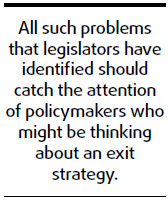Opinion
Vital stimulus check
(China Daily)
Updated: 2009-10-29 08:17
The efforts of Chinese lawmakers to scrutinize the quality and effect of the country's 4-trillion-yuan ($586 billion) stimulus package are more than needed in spite of the initial fruit it has borne in reviving economic growth.
If the country is to make utmost use of such massive public spending to pursue sustainable recovery, it is time to make a thorough assessment and adjust the focus of the stimulus package in line with the quality of economic growth.

The Standing Committee of the 11th National People's Congress (NPC) yesterday reviewed a government report on implementation of the massive public spending program that the country rolled out about a year ago to fight the worst global financial and economic crisis in many decades.
In retrospect, the country's stimulus package has so far worked well enough to enable the Chinese economy to lead the global recovery with what appears to be a remarkable V-shaped rebound.
Though shrinking exports remain a drag, China's economic expansion accelerated from 6.1 percent in the first quarter of this year, the slowest in almost a decade, to 7.9 percent in the second quarter and 8.9 percent in the third.
However, the current sound performance of the government's massive stimulus package does not deny the necessity of a close examination by lawmakers to ensure the quality and efficiency of those investment projects in the future.
If the Chinese government's quick introduction of such a stimulus package in the face of a significantly worsened global slowdown was then largely a matter of expedience, a careful review by the legislature is now a matter of urgency.
With the help of unprecedented credit growth, the country's massive stimulus package has, on the whole, worked its magic to put the Chinese economy in a comfortable position to achieve the annual growth target of 8 percent for this year.
But legislators who have travelled around the country to inspect those public spending programs have found that some of them were not well planned and some others were inadequately financed by local governments.
Clearly, all such problems that legislators have identified should catch the attention of policymakers who might be thinking about an exit strategy.
Regardless of when the country's stimulus package is proposed to be phased out, all the public spending projects will continue to serve the economy for a fairly long period.
A timely check on their quality and efficiency is of long-term importance to the country's economic growth.













